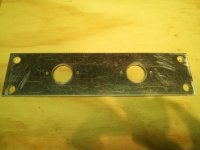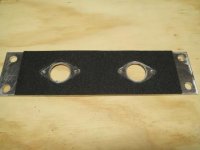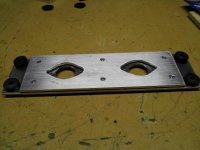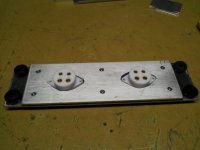Hi djn,
I would be more inclined for a line stage providing the right impedance and current driving capability to drive your cables and input capacitance. That and its sound are more important than the gain factor. The gain can better be provided by a well design driver in the amp
Cheers, ale
Tricky if your set on two stages though, suck it and see i guess!
as i remember the microphonics on my 4p1l's were mainly 2 or 3 resonanses around 1500-2000hz i've tried damping the tubes with limited success and am working on mounting all the gain stages on a highish mass rubber decoupled platform.
all this talk of gyrator drivers is tempting me to dig out my sv811-10'smy gm70 stereo chassis started out as an A2 push pull 811-10 monoblock!
enzo
I made a rather elaborate high mass damped mounting unit for the 26 tubes in my preamp (see picture). Chassis vibrations have to go through in order 2.5mm aluminum chassis, wood mounts, deflex washers, 4mm aluminum, constrained Soundcoat damping material and a teflon socket to get to the tubes. The dissimilar materials should help with limiting sound propagation. It's veeeerrryyy quiet.
Attachments
Thats really impressive ;-)
anyone hear the story of harley davidson and their competitor whos name I cant remember in the I think 30s or 40s?
They both had probems with headlights blowing bulbs. The competitor made a sophisticated arangment using spring mounts etc. harle
y just made them heavy and guess who stood the test
anyone hear the story of harley davidson and their competitor whos name I cant remember in the I think 30s or 40s?
They both had probems with headlights blowing bulbs. The competitor made a sophisticated arangment using spring mounts etc. harle
y just made them heavy and guess who stood the test
Hi djn,
I would be more inclined for a line stage providing the right impedance and current driving capability to drive your cables and input capacitance. That and its sound are more important than the gain factor. The gain can better be provided by a well design driver in the amp
Cheers, ale
Well I am stumped. I always thought an active pre amp and a line stage were the same thing. My Low Mu only has a gain of 5 but it sure makes a big difference.
I'll try and do some bandwidth tests of the ccs loaded 4p1l into some of the higher mu drivers and see how it comes out, on its own into my soundcard it was a hardly down at 90+khz I'll cgeck my notes when I get home, I think 0.5 db @ 60khz at normal listening position on 100k switched attenuator.
Enzo
Enzo
You just need the right level of gain in the preamp without compromising the output impedance. Your low level Mu is fine but I prefer a different topology and valves for a preamp.
Ale
Thanks Ale. so is the term "pre amp" and "line stage" the same thing?
I'm working under that assumption!
enzo
I assume so too E. I might want more gain from the pre if my amp driver could not swing enough for the gm70
I assume so too E. I might want more gain from the pre if my amp driver could not swing enough for the gm70
2 different things: gain and swing capability
I assume so too E. I might want more gain from the pre if my amp driver could not swing enough for the gm70
Yes. Personally I'm more interested in the tone of the preamp valve and its load driving capabilities (e.g. cables, TVC, etc.). I'd expect most of the gain being provided by the driver so the role is more of a line-stage (impedance matching) than of high amplification.
Regarding your swing question: this depends mainly on the valve characteristics and not the gain itself. A valve can provide a lot of gain and may not be able to swing too many volts (or may not be that linear at large voltage swings)....
Swing=Vpp. You can measure with the scope but you may struggle to see minor distortion. You will only see cutoff impact on the signal when is very evident. You will need to somehow adapt your driving signal (e.g. Pete Millett's interface) to your PC and look at the THD. By doing this you can see whether your driver stage can swing your volts required whilst providing minimum distortion. You can use this as a basis to adjust the driver's operating point.
Ale
Last edited:
Yes but if you find a driver that has the swing, drive and distortion you like and it has say a gain of ten, and you need 180vpp into your output tube then from cdp level sources you'll want more than a gain of 0-2 for example. if you had a gain of ten that could get you 20v rms out, give yourself 6db in hand for low recordings and you've still got enough output to swing your driver.
Not a problem with D3a etc but perhaps if you want to use a typicaly low gain DHT and stick with 2 stages it may be of use. holistic innit
enzo
Not a problem with D3a etc but perhaps if you want to use a typicaly low gain DHT and stick with 2 stages it may be of use. holistic innit
enzo
Yes. Personally I'm more interested in the tone of the preamp valve and its load driving capabilities (e.g. cables, TVC, etc.). I'd expect most of the gain being provided by the driver so the role is more of a line-stage (impedance matching) than of high amplification.
Regarding your swing question: this depends mainly on the valve characteristics and not the gain itself. A valve can provide a lot of gain and may not be able to swing too many volts (or may not be that linear at large voltage swings)....
Swing=Vpp. You can measure with the scope but you may struggle to see minor distortion. You will only see cutoff impact on the signal when is very evident. You will need to somehow adapt your driving signal (e.g. Pete Millett's interface) to your PC and look at the THD. By doing this you can see whether your driver stage can swing your volts required whilst providing minimum distortion. You can use this as a basis to adjust the driver's operating point.
Ale
This is where i am a long way behind guys like Ale, i'm still lookin at numbers and have a lot of listening to do!
But swing was what this thread was about, tubes that had the swing to drive gm70's and seeing which could do that at the lowest distortion. Finding the optimum operating points and sharing the info. These are the lowest thd points, not the best sounding per say. For example i've heard it said the 6c45pi sounds 'hard' 'metalic' and 'ss' at over ~ 20ma, well as i raised the currant you could see the 2nd harmonic come steadily down at the same rate the 3,4,5 etc came up. this is a great example of the subjective tallying with the objective. iI posted the low thd point where 2h & 3h ballanced
enzo
All I did was swing enough volts into the test subject to get the 180v out I needed and then adjust the grid bias and currant to find the lowest distortion point. Some rubes I tested were good at small signal swings but even if they could swing the volts they distorted eg pc86, nice low level performance but no good for swings over a few tens of volts pp
The eye opener for me was finding small tubes that performed well in a2, on paper they shouldnt have been able to swing lots of volts at low distortion but in practice they were excellent.
Enzo
The eye opener for me was finding small tubes that performed well in a2, on paper they shouldnt have been able to swing lots of volts at low distortion but in practice they were excellent.
Enzo
I got some 6j52p's delivered today
The interesting thing about this one is that it likes low currents.
Best figures for 67vrms out
Va Vgk Ik rms %
172 1.77 16.6 67 0.32
Best bias for max swing
187 -2.5 10 104 0.59%
so thats ~290p-p from a 340vht 8-0 @0.59
That was the best tube out of a small sample of four, one i didn't test as it's getter plate had made a bid for freedom and the other two did ~.6% at 67vrms.
From these few i.d say that its a good tube, though there are marginally lower distortion tubes that seem more consistent, as a D3a a-like perhaps if you spent the same on some of these as a single d3a you might find one to better the german?
Still, only 3 tested so perhaps a pinch of salt with these results.
enzo
p.s
6p15p-ev and 6p1p to go, then i'll have a look at octals.
The interesting thing about this one is that it likes low currents.
Best figures for 67vrms out
Va Vgk Ik rms %
172 1.77 16.6 67 0.32
Best bias for max swing
187 -2.5 10 104 0.59%
so thats ~290p-p from a 340vht 8-0 @0.59
That was the best tube out of a small sample of four, one i didn't test as it's getter plate had made a bid for freedom and the other two did ~.6% at 67vrms.
From these few i.d say that its a good tube, though there are marginally lower distortion tubes that seem more consistent, as a D3a a-like perhaps if you spent the same on some of these as a single d3a you might find one to better the german?
Still, only 3 tested so perhaps a pinch of salt with these results.
enzo
p.s
6p15p-ev and 6p1p to go, then i'll have a look at octals.
Tested some 5687wb's, These are obviously much lower gain (x 18) compared to the 6p52p's (x 74) so my signal generator only got them to 36vrms, suprisingly these didn't get better with higher current and were as good at 10ma as at 20.
Infact unlike the triode strapped pentodes they were very stable over the biases I tested them at, as long as they were biased out of A2. Best i got was 0.6% @ 36vrms/100vp-p. I wont be using these, but their stability could be of use to some?
enzo
Infact unlike the triode strapped pentodes they were very stable over the biases I tested them at, as long as they were biased out of A2. Best i got was 0.6% @ 36vrms/100vp-p. I wont be using these, but their stability could be of use to some?
enzo
I had some 6j9p-e delivered, they are a very obviously not the same as the 6j9p, seem the same design but built like tanks.
I had high hopes for these as perhaps they could take the extra dissipation needed to get the best out of the little 6j9p.
Well they dont like going into possitive grid voltages :-(
Both @67vrms, 6j9p best of 2, 6j9p-e best of 10.
Va Ik Vgk %
6j9p-e 220 26ma -3.6 0.55 5.72w
6j9p 229 26ma -2.4 0.057 5.95w
6j9p 204 21.5 -2.3 0.09 4.2w
0.057%
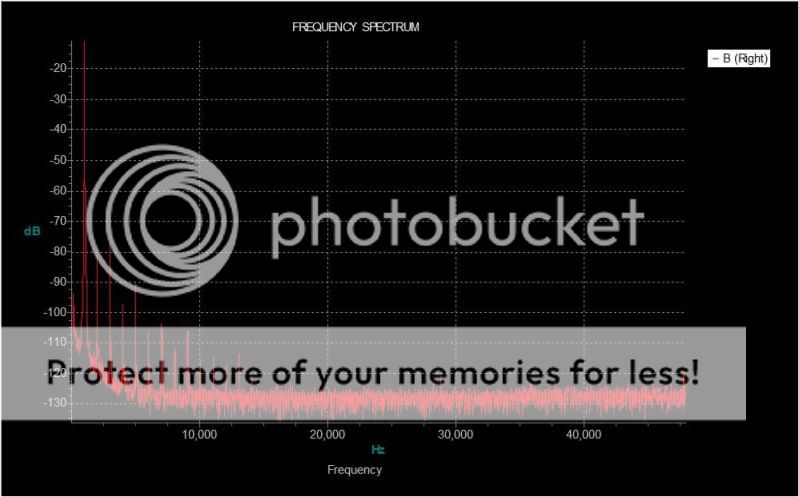
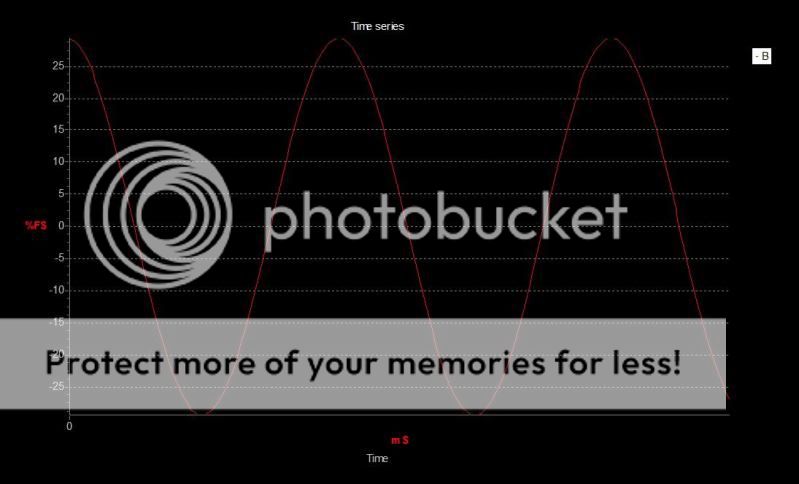
enzo
I had high hopes for these as perhaps they could take the extra dissipation needed to get the best out of the little 6j9p.
Well they dont like going into possitive grid voltages :-(
Both @67vrms, 6j9p best of 2, 6j9p-e best of 10.
Va Ik Vgk %
6j9p-e 220 26ma -3.6 0.55 5.72w
6j9p 229 26ma -2.4 0.057 5.95w
6j9p 204 21.5 -2.3 0.09 4.2w
0.057%


enzo
Last edited:
Can you explain swing. I never really understood what that is. How do I measure swing?
basically the plate voltage of the driver tube, say you have 250volts on the driver plate, the driver swing therefore can be 200volts peak allowing for 50volt tube saturation voltage....
- Status
- This old topic is closed. If you want to reopen this topic, contact a moderator using the "Report Post" button.
- Home
- Amplifiers
- Tubes / Valves
- gm70 driver tube tests
